Ministry of Jal Shakti
India’s first water bodies census released by Ministry of Jal Shakti
Maharashtra leads in Water Conservation Schemes
Posted On:
25 APR 2023 3:48PM by PIB Mumbai
Delhi/Mumbai: 25 April 2023
The Ministry of Jal Shakti has released the report of India’s first water bodies census, a comprehensive data base of ponds, tanks, lakes, and reservoirs in the country. The census was conducted in 2018-19, and enumerated more than 2.4 million water bodies across all states and Union Territories.
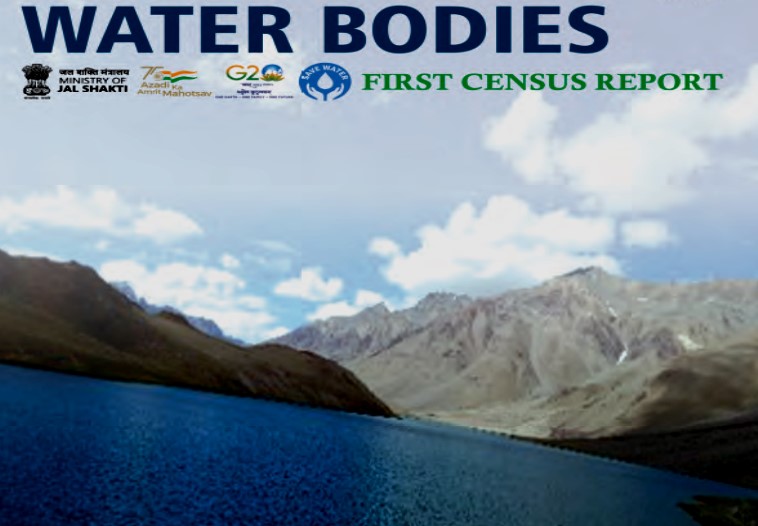
In this census, water bodies are defined as follows.
All natural or man-made units bounded on all sides with some or no masonry work used for storing water for irrigation or other purposes (e.g. industrial, pisciculture, domestic/drinking, recreation, religious, ground water recharge etc.) will be treated as water bodies in this Census. These are usually of various types known by different names like tank, reservoirs, ponds etc. A structure where water from ice-melt, streams, springs, rain or drainage of water from residential or other areas is accumulated or water is stored by diversion from a stream, nala or river will also be treated as water body.
The objective of the Census of Water Bodies is to develop a national database for all water bodies by collecting information on all important aspects of the subject including their size, condition, status of encroachments, use, storage capacity, status of filling up of storage etc.
As per the report, 24,24,540 water bodies have been enumerated in the country, out of which 97.1% (23,55,055) are in rural areas and only 2.9% (69,485) are in urban areas. 59.5% (14,42,993) of water bodies are ponds, followed by tanks (15.7%, i.e 3,81,805), reservoirs (12.1%, i.e 2,92,280), Water conservation schemes/percolation tanks/check dams (9.3%, i.e 2,26,217), lakes (0.9%, i.e 22,361) and others (2.5%, i.e 58,884).
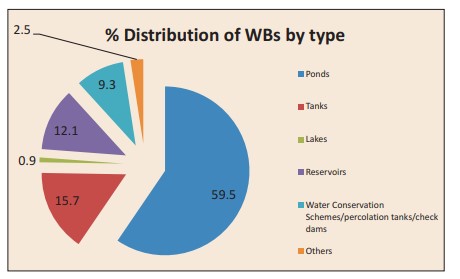
It is a matter of pride for Maharashtra, that Maharashtra State is the leading state for water conservation schemes. Whereas West Bengal has highest number of ponds & reservoirs, whereas Andhra Pradesh has highest number of tanks, Tamil Nadu has highest number of lakes.
First census of water bodies was conducted with reference year 2017-18 across the country in 33 States/UTs except Daman & Diu, Dadra & Nagar Haveli and Lakshadweep. One of the many important things in this report is that Maharashtra is at the top in water conservation scheme category.
In 1st census of water bodies, 97,062 water bodies have been enumerated in the State of Maharashtra, out of which 99.3% (96,343) are in rural areas and the remaining 0.7% (719) are in urban areas. Majority of the water bodies are water conservation schemes as depicted from chart given below.
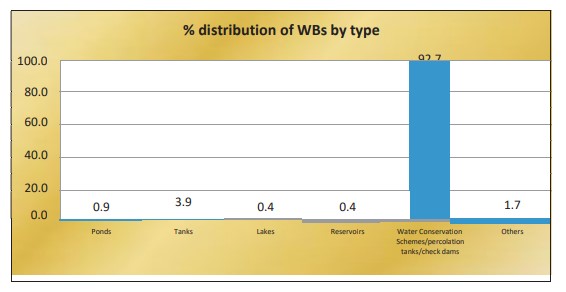
99.7% (96,767) water bodies are public owned whereas the remaining 0.3% (295) are under private ownership. This reflects the dominance of public entities in ownership of water bodies. Distribution of water bodies by type of ownership is shown in the charts given below.
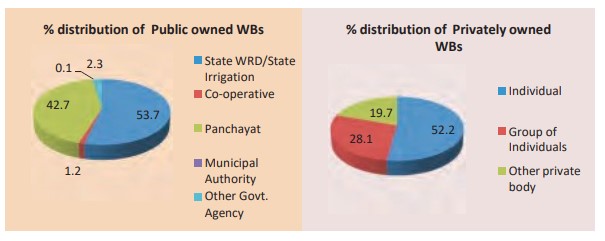
Out of all water bodies in Maharashtra, 98.9% (96,033) water bodies are "in use" whereas rest 1.1% (1,029) are "not in use" on account of drying up, siltation, destroyed beyond repair and other reasons. Out of 'in use' water bodies, a major proportion of water bodies are used in ground water recharge followed by domestic/ drinking and irrigation purpose. Percentage distribution of water bodies by type of use is shown in the diagram given below.
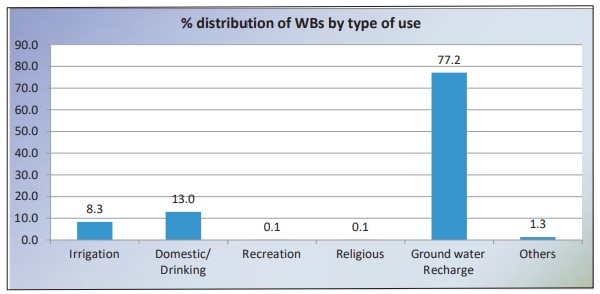
Maharashtra’s Aurangabad, Jalna and Nashik are among the top 5 Districts In Various Use Of Water Bodies.
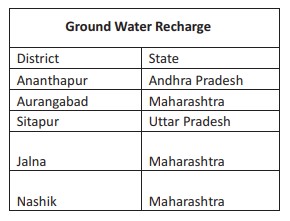
In the State of Maharashtra, there are 574 natural and 96,488 man-made water bodies. Out of 574 water bodies, 98.4% (565) are located in rural areas whereas remaining 1.6% (9) are located in urban areas. Out of 96,488 manmade water bodies, 99.3% (95,778) water bodies are located in rural areas and the remaining 0.7% (710) are located in urban areas. Most of the man-made water bodies have original cost of construction between Rs.5 to Rs.10 Lakhs.
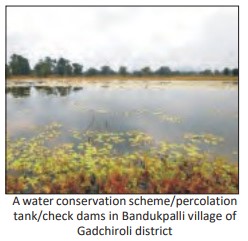
Based on the criteria of filling up of storage capacity during last 5 years, out of 5,403 water bodies, 63.2% (3,414) water bodies are found to be filled up every year, 35.8% (1,935) are usually filled up, 0.7% (38) are rarely filled up and 0.3% (16) are never filled up. Percentage distribution of water bodies by 'status of filling' and 'filled up storage capacity' is shown in the diagrams given below.
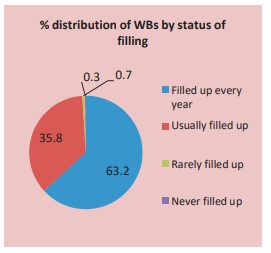
Out of all water bodies in Maharashtra , 60.7% (58,887) are covered in District Irrigation Plan/State Irrigation Plan. Among these 90.8% (53,449) are water conservation schemes/percolation tanks/check dams and the remaining 9.2% (5,438) are tanks, lakes, reservoirs etc. Out of 'in use' water bodies, 82.5% (79,238) are benefitting one (01) city/town, 17.1% (16,406) water bodies are fulfilling requirements of 2-5 cities/ towns and the remaining 0.4% (389) are benefitting more than five (05) cities/towns. State has reported encroachment in 251 water bodies, out of which 233 are water conservation schemes/percolation tanks/check dams.
In terms of storage capacity, 94.8% (92,026) water bodies in Maharashtra have storage capacity between 0-100 cubic meters whereas 4% (3,885) have storage capacity between 100 to 1,000 cubic meters.
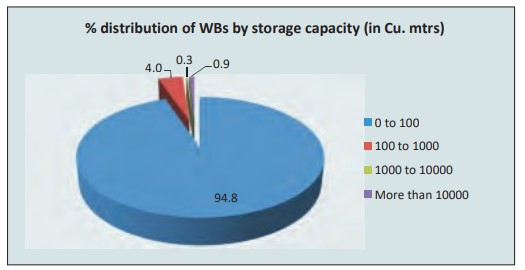
Link to Download All India Report: https://jalshakti-dowr.gov.in/document/all-india-report-of-first-census-of-water-bodies-volume-1/ ;
State Wise Report: https://jalshakti-dowr.gov.in/document/state-wise-report-of-first-census-of-water-bodies-volume-2/
MM/JPS/Stupe/PM
Follow us on social media: @PIBMumbai
@PIBMumbai  /PIBMumbai
/PIBMumbai  /pibmumbai
/pibmumbai  pibmumbai[at]gmail[dot]com
pibmumbai[at]gmail[dot]com  /PIBMumbai
/PIBMumbai  /pibmumbai
/pibmumbai
(Release ID: 1919482)
Visitor Counter : 37210